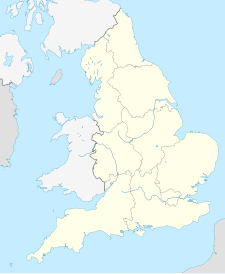St Crispins Hospital
| St Crispin's Hospital | |
|---|---|

The Asylum as it is today, the ward in view behind the tower has been converted to flats
|
|
| Geography | |
| Location | Northampton, England |
| Coordinates | 52°14′35″N 0°57′29″W / 52.243°N 0.958°W |
| Organisation | |
| Affiliated university | None |
| Patron | None |
| Services | |
| Helipad | No |
| History | |
| Founded | 1876 |
| Links | |
St Crispins was a large psychiatric hospital on the outskirts of Duston village in Northampton, Northamptonshire, England.
It was established in 1876 as the Berrywood Asylum and closed in 1995. Its grounds and the surrounding area include a new psychiatric hospital, residential housing, a large self-contained retirement village, a primary school and a local centre of shops and offices.
Until the 1870s the County and Borough of Northampton's pauper lunatics occupied space under a contract with the Northampton General Asylum (now St Andrew's Hospital), a public subscription asylum located to the east of Northampton. With intervention from the Commissioners in Lunacy, who believed the current arrangement to be inappropriate, it was decreed that the county should own and maintain its own premises. Despite extensions and attempts to purchase the existing asylum, it was decided that a new county establishment would be built instead and land was purchased at Upton close to the village of Duston in the countryside to the north-west of Northampton.
On opening, all rate-aided patients in Northampton General Asylum were relocated to the new Berrywood asylum and the contract at the Northampton General Asylum ceased, the latter thereafter admitting principally non-pauper inmates.
The new asylum was built to make good use of its position, with extensive views to the south overlooking open farmland towards Upton and protected to the north by the Berrywood itself, owned as part of the estate and providing a visual buffer from the village and road. The grounds incorporated a large farm complex, gas works, burial ground, a number of cottages for attendants and other estate staff, large residences for the superintendent, farm bailiff, head gardener, chaplain and steward. The main building was built to a variation of the corridor-pavilion plan and consisted of two major patient's blocks on either side of the central services and hall, and linked only by single storey corridors and open metal walkways at upper levels. The design reflected the architect, Robert Griffiths' previous work at the Macclesfield Asylum, Cheshire by placing pairs of projecting blocks for acute and generalised cases forward of the building line where the most benefit was received from light and fresh air, linked by infirmary wards, still with good prospect but protected from the worst of the weather and forming a segregation of management class of inmate. Unlike at Macclesfield, the acute and infirmary blocks were united, but still bore a similar form. To either end were located the blocks for chronic, turbulent and difficult patients who it was proposed would gain less from the good aspect, but was to provide good access to their places of work.
...
Wikipedia

